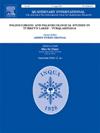Dating the ebb and flow of Tiwanaku and post-collapse material culture across the Andes
IF 1.8
3区 地球科学
Q3 GEOGRAPHY, PHYSICAL
引用次数: 0
Abstract
This paper presents a comprehensive Bayesian refinement of the chronology of Tiwanaku material culture. To place this material pattern in space, we present a presence-only map of most sites with Tiwanaku redware ceramics, snuff trays, and textiles. We compile radiocarbon dates and assess their material associations before building Bayesian models. We present bespoke calibration curve mixtures for each major region, based on air mixtures from climate models. The models suggest that redwares burst onto the scene in the AD 600s in the Lake Titicaca Basin (Peru and Bolivia) and around the same time, snuff trays with the same iconography appeared in burials at San Pedro de Atacama (Chile). Other parts of the Andes first saw this material culture later, and only in the AD 900s was it clearly present in all regions. Around ∼AD 1040, Tiwanaku redwares were no longer used at Tiwanaku or in Moquegua. Residents of the Western Valleys immediately innovated new post-collapse styles derived from Tiwanaku redwares, appearing and fading away at different times in different valleys. A small community near Lake Titicaca maintained old traditions for generations, including the use of raised fields and Tiwanaku burials. We assess temporal alignments and disjunctures in order to highlight variability of Tiwanaku material culture, long assumed to be fairly homogeneous over space and time. This opens the door to more nuanced, generation-scale questions about the interaction networks that assembled and disassembled Tiwanaku.
确定蒂瓦纳库的兴衰和崩塌后安第斯山脉的物质文化的年代
本文对蒂瓦纳库物质文化年表进行了全面的贝叶斯细化。为了将这种材料模式放置在空间中,我们呈现了一幅只有Tiwanaku红色陶瓷,鼻烟托盘和纺织品的大多数站点的存在地图。在建立贝叶斯模型之前,我们编制放射性碳年代并评估它们的物质关联。我们根据气候模型的空气混合物,为每个主要地区提供了定制的校准曲线混合物。这些模型表明,公元600年,红陶器在的的喀喀湖盆地(秘鲁和玻利维亚)突然出现,大约在同一时间,在圣佩德罗德阿塔卡马(智利)的葬礼上出现了带有相同图案的鼻烟壶托盘。安第斯山脉的其他地区最早看到这种物质文化的时间较晚,直到公元900年,这种物质文化才在所有地区明显存在。大约在公元1040年左右,蒂瓦纳库或莫克瓜不再使用蒂瓦纳库的红器。西部山谷的居民立即从蒂瓦纳库红陶器中衍生出了新的崩溃后风格,在不同的山谷中不同的时间出现和消失。的的喀喀湖附近的一个小社区几代人都保持着古老的传统,包括使用高地和蒂瓦纳库墓地。我们评估时间排列和断裂,以突出蒂瓦纳库物质文化的可变性,长期以来被认为在空间和时间上是相当均匀的。这打开了一扇门,让我们了解到更多微妙的、世代尺度的问题,即组装和拆卸Tiwanaku的互动网络。
本文章由计算机程序翻译,如有差异,请以英文原文为准。
求助全文
约1分钟内获得全文
求助全文
来源期刊

Quaternary International
地学-地球科学综合
CiteScore
5.60
自引率
4.50%
发文量
336
审稿时长
3 months
期刊介绍:
Quaternary International is the official journal of the International Union for Quaternary Research. The objectives are to publish a high quality scientific journal under the auspices of the premier Quaternary association that reflects the interdisciplinary nature of INQUA and records recent advances in Quaternary science that appeal to a wide audience.
This series will encompass all the full spectrum of the physical and natural sciences that are commonly employed in solving Quaternary problems. The policy is to publish peer refereed collected research papers from symposia, workshops and meetings sponsored by INQUA. In addition, other organizations may request publication of their collected works pertaining to the Quaternary.
 求助内容:
求助内容: 应助结果提醒方式:
应助结果提醒方式:


